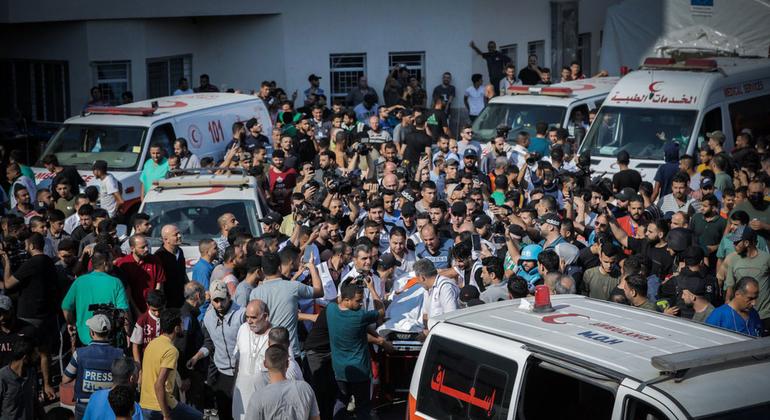Speaking from the southern city of Rafah, Dr. Rick Peeperkorn, World Health Organization (WHO) Representative on the Occupied Palestinian Territory, described further bloodshed after the resumption of Israeli bombing last Friday.
“The situation is getting worse by the hour,” Dr. Peeperkorn told journalists in Geneva via video link. “I mean…there’s intensified bombing going on all around and including here in the southern areas, Khan Younis and even in Rafah.”
The WHO medic noted that in the last couple of days there had also been “a vastly increasing number” of internally displaced people travelling from the Middle area “and even now the southern areas”, fearing for their lives.
Echoing those concerns, UN Children’s Fund spokesperson James Elder cited international humanitarian law that obliges militaries to “take all feasible measures” to protect civilians. It was not acceptable to unilaterally declare that they should go to “so-called safe zones”, he insisted, when these were in fact “sidewalks” or “half-built buildings” without water, shelter or sanitation.
“It’s not a safe zone if it’s only free from bombardment, as some zones have not been,” Mr. Elder said.
Deadly toll
The humanitarian update came as the UN aid coordination office, OCHA, reported that between the afternoon of 3 December and the afternoon of 4 December at least 349 Palestinians were killed and 750 injured, according to the Ministry of Health (MoH) in Gaza.
Three Israeli soldiers were also killed, according to Israeli sources, OCHA said in its latest emergency update.
8 in 10 Gazans now homeless
According to the UN agency for Palestinian refugees, UNWRA, nearly 1.9 million people – more than 85 per cent of the population in Gaza – have been displaced across the Strip since 7 October.
Almost 1.2 million internally displaced persons have found shelter in 156 UNRWA installations across all five governorates of the Gaza Strip, including the North and Gaza City, the UN agency said.
It also confirmed that at least 19 additional colleagues had been killed during airstrikes, bringing the total to 130 since 7 October. “We are also in danger as we walk,” UNWRA said, quoting one of its counsellors, named only as Jehan. “Our lives are at a standstill…There is the smell of death here. But we’re determined to live.”
Aid lifeline
Health authorities in Gaza estimate that at least 15,523 Palestinians have been killed in Gaza in the latest escalation, with 70 per cent believed to be women and children. “Many more are missing, presumably under the rubble, waiting for rescue or recovery,” UNRWA said.
Amid desperate shortages of all humanitarian supplies, OCHA reported that on Sunday, some 100 aid trucks reached the enclave, along with 69,000 litres of fuel. The same quantities reached Gaza on Saturday, the UN aid office said, noting that this was still “well below” the daily average of 170 trucks and 110,000 litres of fuel delivered during the pause in fighting from 24 and 30 November.
“It’s too little, it’s way too little,” said WHO’s Dr. Peeperkorn, who said that amid the “increasing disaster” of Gaza, more medicine, food, water and fuel were needed.
Describing Gaza’s healthcare infrastructure as “crippled” with “hardly any functional health facility in the north” apart from Al-Ahli hospital which was inundated with multiple trauma cases and a lack of supplies, the WHO official expressed deep concern that the same desperate scenes could be repeated in the south.
Patients’ plight
From a capacity of 3,500 beds before the 7 October escalation, the enclave now has only 1,500, he explained.
“If you look around, there’s hardly any hospital there left (in the north). So, we’ve seen what happened in northern Gaza and of course we are deeply concerned that this cannot be – this should not be – a blueprint for the south.”
The WHO official also confirmed that medical supplies had been moved from two warehouses from Khan Younis to Rafah on Sunday. This followed advice that the storage facilities were “in an area where the population was told to evacuate and would most likely become an area of active combat in the coming days”, he explained.
ends


